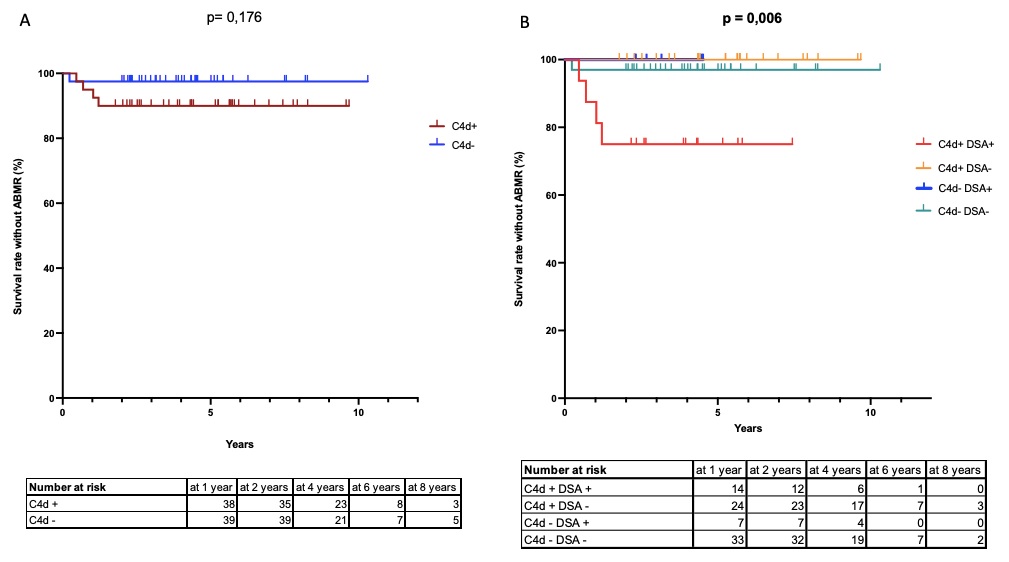Evaluation of the Significance of Isolated C4d Staining without Histological Evidence of Rejection on Kidney Biopsies After ABO-Compatible Transplantation in Pediatric Recipients
1Pediatric Nephrology, Robert Debré Hospital, APHP, Paris, France, 2Pathology, Necker Hospital, Paris, France, 3Pediatric Nephrology, Necker Hospital, Paris, France
Meeting: 2022 American Transplant Congress
Abstract number: 838
Keywords: Biopsy, Kidney, Pediatric, Rejection
Topic: Clinical Science » Kidney » 43 - Kidney: Pediatrics
Session Information
Session Time: 5:30pm-7:00pm
 Presentation Time: 5:30pm-7:00pm
Presentation Time: 5:30pm-7:00pm
Location: Hynes Halls C & D
*Purpose: C4d staining in peritubular capillaries has been part of ABMR Banff definition since 2003. Despite relatively high specificity, c4d staining shows limited sensitivity, and the clinical significance of C4d+ biopsies without other histological evidence of rejection (WER) is unknown. We aimed to assess the clinical significance of c4d+ biopsies WER on kidney biopsies after ABO-compatible transplantation in pediatric recipients.
*Methods: We retrospectively analyzed patients under 18 years with c4d+WER biopsies performed between 2011-2020, in 2 pediatric transplant centers in Paris, France. All biopsies were reviewed by a single expert pathologist to confirm the immunohistochemical C4d+ staining and to ensure the absence of ABMR or TCMR. C4d+ WER patients were compared with a cohort of C4d- patients matched on recipients’ demographics, year and center of transplantation, biopsy indication and time to transplantation.
*Results: 6% of biopsies were C4d+WER. 40 C4d+WER children were compared with 40 matched C4d- controls (median age 12 and 11,6 years). 65% were protocol biopsies performed within the 1st year after transplant (median 6,9 months, IQR 2,5-15,2). There was no significant difference regarding recipient, donor, or transplant characteristics. However, C4d+ patients showed significantly more DSA on the day of biopsy (40% vs 17,5%, p=0,047). After a 4-years median follow-up, 4/40 C4d+ patients developed an ABMR within year 1 (10,4 months, IQR 6,2-14,0). All these patients were DSA+ at the time of biopsy. However, among the patients who had a follow-up biopsy (n=32), we noted a negativation of C4d staining in 78%, including 20/32 patients (62%) in the absence of specific treatment. Survival rate without ABMR did not differ between C4d+ and C4d- patients (Fig A). However, C4d+ DSA+ patients developed significantly more ABMR within the 1st-year post biopsy compared with C4d+DSA- and C4d- patients (Fig 2). Interestingly, patient characteristics and outcomes of C4d+DSA- patients did not differ from C4d- patients.
*Conclusions: C4d+WER biopsies DSA- do not represent an increased risk of ABMR compared to C4d- patients. Molecular analysis of the biopsies may help to assess the significance and clinical implication of C4d+WER in pediatric kidney transplant recipients.
To cite this abstract in AMA style:
Duneton C, Rabant M, Duong-Van-Huyen J, Baudouin V, Cheyssac E, Boyer O, Hogan J. Evaluation of the Significance of Isolated C4d Staining without Histological Evidence of Rejection on Kidney Biopsies After ABO-Compatible Transplantation in Pediatric Recipients [abstract]. Am J Transplant. 2022; 22 (suppl 3). https://atcmeetingabstracts.com/abstract/evaluation-of-the-significance-of-isolated-c4d-staining-without-histological-evidence-of-rejection-on-kidney-biopsies-after-abo-compatible-transplantation-in-pediatric-recipients/. Accessed December 23, 2025.« Back to 2022 American Transplant Congress

